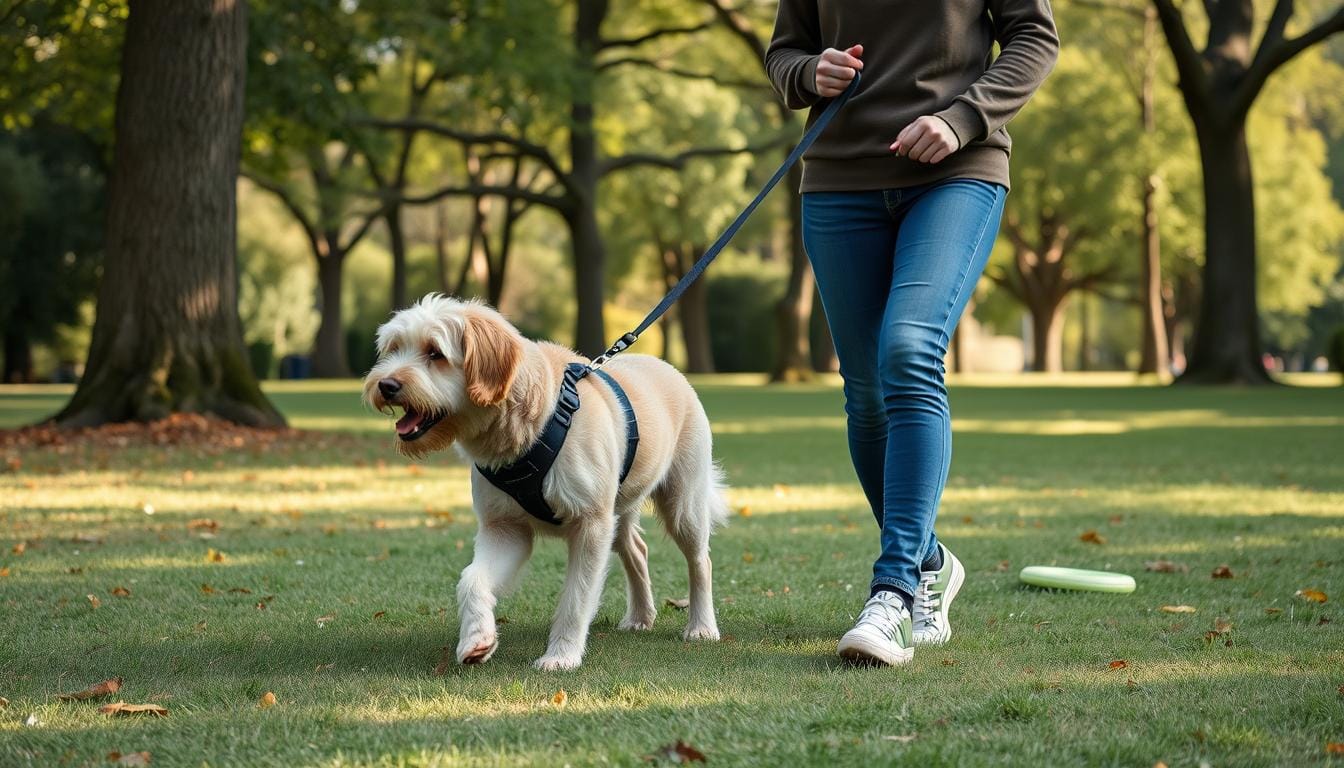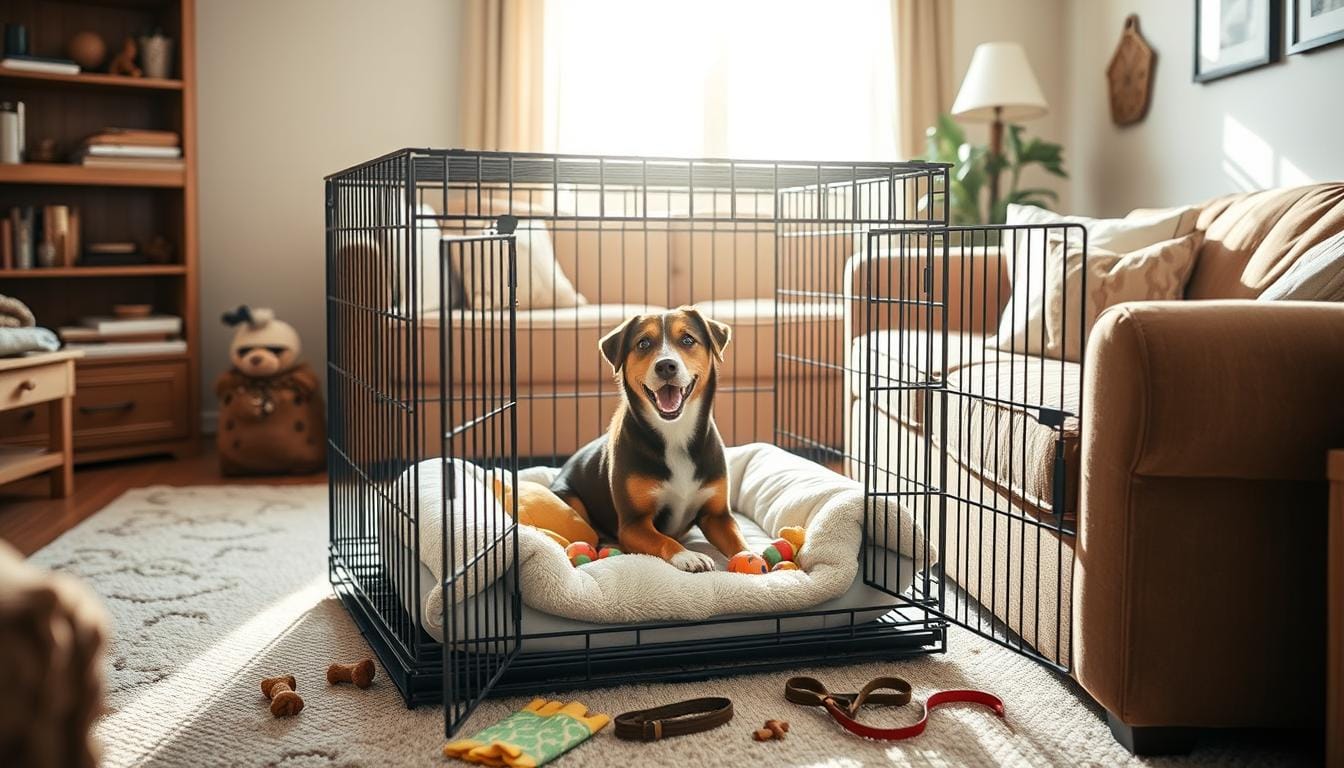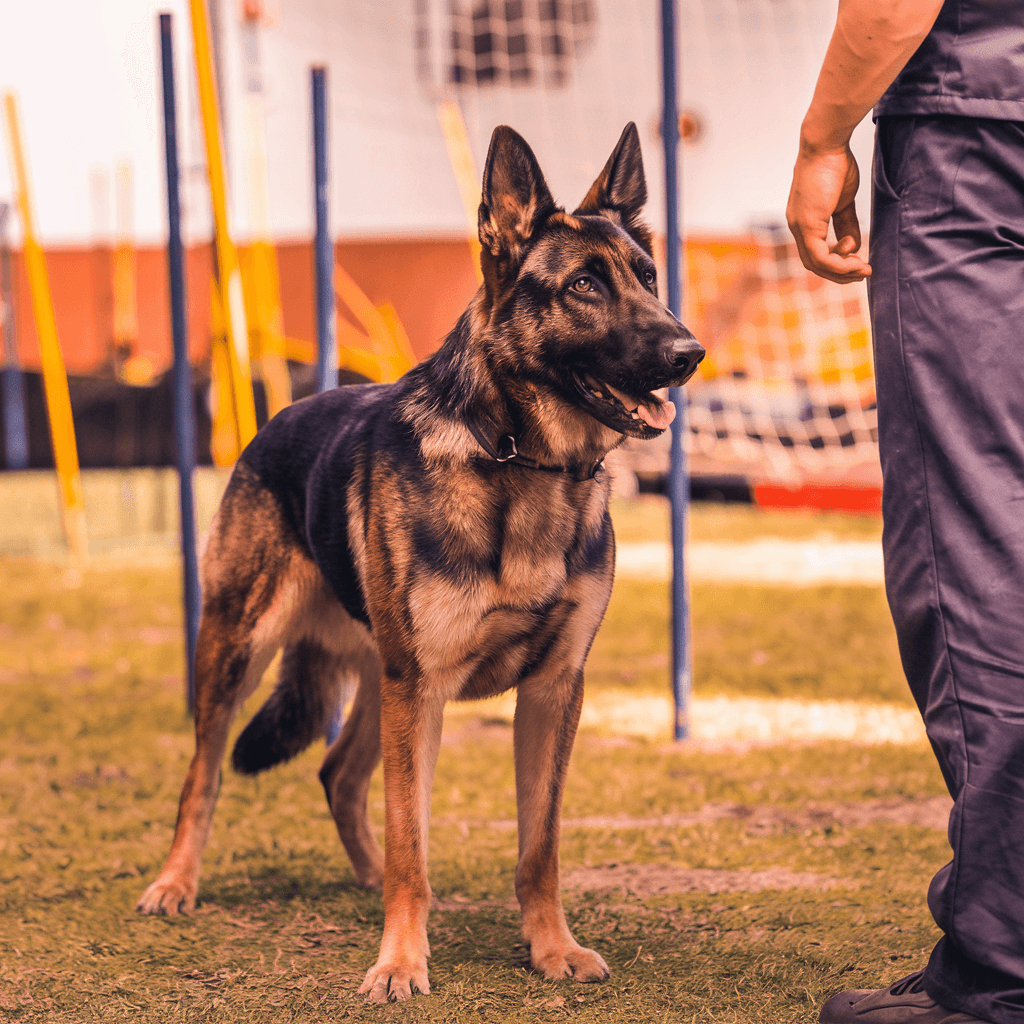Dogs can sense human emotions instinctively. They pick up on our feelings, often before we do. Dogs use body language, facial expressions, and scent to understand us.
Understanding dog eating habits and appetite is key. We must learn to read their signals about food and health. This includes knowing when they might need to fast.
Let’s explore how long a dog can go without eating. We’ll share important info for pet owners to keep their dogs healthy and happy. Join us to learn more about our loyal companions and our bond with them.
Key Takeaways
- Healthy dogs can typically survive 3-5 days without food, but not without risks
- Water intake is more critical, with dogs only lasting about 3 days without it
- Sick or elderly dogs may face health risks after just 1-2 days without eating
- Prolonged fasting can lead to organ damage and other serious health issues
- Consult a veterinarian if your dog refuses food for more than 48 hours
- Monitoring your dog’s behavior and appetite is crucial for their well-being
Understanding Canine Eating Habits
It’s key to know your dog’s eating habits for their nutrition. Each dog is different, with their own food likes. We’ll look at normal eating patterns, what affects appetite, and signs of a healthy appetite.
Normal eating patterns in dogs
Adult dogs usually eat once or twice a day. Puppies and older dogs might need more meals. Healthy adult dogs can skip food for 3-5 days, but they must have water. Small breeds should not fast for over 3 days.
Factors affecting a dog’s appetite
Many things can change a dog’s appetite:
- Age and health status
- Activity level
- Environmental changes
- Stress or anxiety
- Medications
Loss of appetite can mean illness, dental problems, or bad reactions to vaccines or meds. If your dog hasn’t eaten for days, especially after a week, see a vet.
Signs of a healthy appetite in dogs
A healthy dog will:
- Eagerness at mealtimes
- Consistent eating habits
- Stable weight
Dogs have different food preferences. Some are pickier than others. If your dog’s eating habits change, watch them closely. You might need to adjust their diet or feeding schedule.
How Long Can a Dog Go Without Eating?

Dogs can usually go 3 to 5 days without food. But it’s not safe or healthy for them. The time a dog can skip meals depends on their size, age, and health.
Small dogs like Chihuahuas might only last 2 to 3 days without food. Big dogs, like Great Danes, can go up to 5 days. Puppies, with their growing bodies, should not go more than 12 hours without eating.
Healthy adult dogs might survive a week without solid food. But, fasting for too long can cause serious health problems. After 48 hours without food, it’s best to see a vet.
| Dog Type | Safe Fasting Duration |
|---|---|
| Small Breeds | 2-3 days |
| Large Breeds | Up to 5 days |
| Puppies | 12 hours maximum |
Water is more important for dogs than food. Dehydration can be deadly faster than starvation. If your dog won’t drink water for a day, get vet help right away.
Dog hunger doesn’t always mean they’re sick. But, not eating for a long time can harm their muscles and organs. If your pet stops eating for a while, act fast to avoid serious health issues.
Reasons Why Dogs Might Stop Eating
Dogs can suddenly lose interest in food for many reasons. It’s important to know why they stop eating to help them. Let’s look at the main reasons for anorexia in dogs or refusal to eat.
Medical Causes
Health problems often make dogs not want to eat. Dental issues, infections, and organ diseases can affect their appetite. Vaccines might also make them eat less. Serious problems like cancer or kidney failure can cause them to stop eating altogether.
Psychological Factors
A dog’s mental state is key to their eating habits. Stress, anxiety, or depression can make them not want to eat. Changes in their routine or environment can upset them, leading to loss of appetite.
Environmental Influences
The environment can greatly affect a dog’s appetite. New places, travel, or meeting new people or animals can make them not want to eat. Even small changes at home can upset some dogs.
| Factor | Impact on Appetite | Duration |
|---|---|---|
| Medical Issues | Significant decrease | Varies (days to weeks) |
| Psychological Stress | Moderate to severe decrease | Short-term (hours to days) |
| Environmental Changes | Mild to moderate decrease | Usually short-term (1-3 days) |
Finding out why your dog is not eating is key to helping them. If they keep refusing food, see a vet. Remember, a FitBark GPS can track their activity, which can show if they’re eating less.
The Importance of Water Intake for Dogs
Water is key for keeping dogs hydrated and healthy. The amount of water a dog needs depends on its size, diet, and how active it is. A good rule of thumb is 1 ounce of water per pound of body weight each day. Dogs that eat wet food might need less, since their food gives them a lot of water.
It’s important to know the signs of dehydration in dogs. Look for dry gums, sticky saliva, sunken eyes, and skin that doesn’t spring back when pressed. These signs mean your dog might be very sick and needs help right away.
Dehydration is a big risk for dogs. It can hurt their organs and even cause organ failure if not treated. Dogs with health issues like kidney disease or cancer are more at risk. Puppies and older dogs also need extra care to stay hydrated.
To help your dog stay hydrated:
- Make sure they have fresh, clean water every day
- Keep their water bowls clean
- Watch how much water they drink, especially when it’s hot
- Give them water-rich foods like cucumber or watermelon as treats
| Dog Size | Daily Water Intake | Max Time Without Water |
|---|---|---|
| Small (up to 20 lbs) | 1-2 cups | 12-24 hours |
| Medium (21-50 lbs) | 2-4 cups | 24-48 hours |
| Large (51+ lbs) | 4+ cups | 48-72 hours |
Keep in mind, these are just general tips. If you’re worried about your dog’s hydration or health, always talk to a vet.
Health Risks Associated with Prolonged Fasting in Dogs
Fasting risks for dogs can be severe if not managed properly. Some studies suggest benefits of intermittent fasting. But, prolonged fasting can lead to serious health issues. We’ll look at the short-term effects, long-term consequences, and warning signs of canine malnutrition.
Short-term effects
Dogs without food for too long may feel weak, tired, and nauseous. These symptoms can appear quickly, especially in puppies and senior dogs. It’s important to watch your pet’s behavior and energy during fasting.
Long-term consequences
Prolonged fasting can cause serious problems. It can damage organs, waste muscles, and weaken the immune system. These effects can harm your dog’s health and quality of life for a long time.
When to be concerned
If your dog hasn’t eaten for 48 hours or seems sick, get vet help. Puppies and senior dogs are more at risk and may need help sooner. Look out for these warning signs:
- Vomiting yellow or green fluid
- Lethargy or weakness
- Refusal to drink water
- Visible weight loss
While some studies suggest benefits of short-term fasting for dogs, always talk to a vet first. Your pet’s health and safety should always come first.
How to Encourage a Dog to Eat
Getting a dog to eat can be tough, but there are ways to make it easier. We’ll look at some tips to make mealtime better for your dog.

Warming up your dog’s food is a simple trick. It makes the smell more inviting. You can also add a bit of low-sodium broth to their kibble to make it tastier.
Getting your dog to move before meals can help. A quick walk or playtime can make them hungrier. Also, eating in a quiet spot and at the same time every day can help.
If your dog is picky, try different foods. Some dogs like wet food better than dry kibble. Hand-feeding or using fun feeding toys can also make them more interested in eating.
| Strategy | Description | Effectiveness |
|---|---|---|
| Warm food | Enhances aroma and palatability | High |
| Add broth | Improves flavor and moisture | Medium |
| Pre-meal exercise | Stimulates appetite | Medium |
| Vary food texture | Caters to preferences | High |
| Interactive feeding | Makes eating more engaging | Medium |
If these tips don’t work, see a vet. They can check for health problems and give advice just for your dog.
Special Considerations for Puppies and Senior Dogs
Dogs need different foods at different times in their lives. This is true for puppies and older dogs. It’s important to feed them right to keep them healthy and happy.
Puppy Nutrition Needs
Puppies are full of energy and need to eat often. A 3-month-old puppy can go without food for 4-6 hours. But a 6-month-old can go up to 8 hours.
Newborn puppies need to nurse every 2-3 hours. This helps prevent low blood sugar and dehydration.
Puppies should not go more than 6 hours without water. If they don’t drink, they might get sick. Look out for signs like shaking, weakness, and pale gums.
Elderly Dog Dietary Requirements
Dogs over seven years old are considered seniors. They need special food that’s easy to digest. This food also helps keep their joints healthy.
- Annual blood and urine tests to detect early signs of diseases
- Weight monitoring every two months
- Adjusting calorie intake based on activity level
Adjusting Feeding Schedules
As dogs get older, their diet needs to change. Puppies eat 3-4 times a day. Adult dogs usually eat twice a day. Senior dogs might do better with smaller meals more often.
Both puppies and seniors are more sensitive to fasting. If they don’t want to eat, see a vet right away. Regular vet visits help keep them healthy and adjust their diet as needed.
When to Consult a Veterinarian
It’s important to know when to see a vet for your dog’s appetite loss. Call your vet if your dog hasn’t eaten in 48 hours or shows signs of illness like vomiting or diarrhea. These could be signs of serious health issues.
Puppies and senior dogs need quicker action. If they stop eating for 24 hours, get them to the vet right away. Look out for sudden weight loss, pale gums, or trouble breathing too.
Regular vet visits can help find and fix appetite problems early. This can stop more serious health issues. Remember, not eating for too long can cause dehydration and malnutrition, which are very bad for your dog.
| Symptom | When to Consult a Vet |
|---|---|
| No eating | After 48 hours |
| No drinking | After 24 hours |
| Vomiting or diarrhea | Immediately |
| Sudden weight loss | Within 24 hours |
If you see any of these signs, get help fast. Early action can really help with your dog’s appetite loss and prevent bigger problems. Your vet can give the right advice and care to keep your dog healthy.
Nutrition and Diet Tips for Maintaining a Healthy Appetite
A balanced dog diet is key to your furry friend’s health and appetite. We’ve got some important tips to help meet your dog’s nutritional needs. These tips will also help you establish healthy feeding practices.
Start by choosing high-quality dog food that fits your pet’s age, size, and activity level. Look for food with the right mix of protein, fat, and carbs. Mixing wet and dry food can make mealtime more interesting and prevent boredom.
Regular exercise is vital for keeping hunger and health in check. Take your dog for walks or play fetch to keep them active. This helps them stay at a healthy weight and keeps their appetite strong.
- Monitor portion sizes and adjust as needed
- Avoid overfeeding treats, which can reduce mealtime appetite
- Stick to a consistent feeding schedule
- Provide fresh water at all times
If your dog is a picky eater, try different flavors and textures. Some dogs prefer certain tastes or moisture levels in their food. Be patient and try different options until you find what works best for your pet.
“A well-balanced diet and regular exercise are the cornerstones of maintaining a healthy appetite in dogs.”
Remember, every dog is different. Watch your pet’s eating habits closely. If you notice any big changes in appetite or behavior, talk to a vet. With the right diet and exercise, your dog will stay happy, healthy, and eager for meals.
Common Misconceptions About Dog Feeding
There’s a lot of information about dog nutrition out there. But not all of it is true. Let’s look at some common myths and the facts behind them.
Myth vs. Reality in Canine Nutrition
Many think dogs can safely fast for a long time. But, long-term fasting can be risky. Another myth is that high protein diets harm dogs with kidney issues. Veterinarians still debate this.
Grains, often seen as bad in dog food, can actually be good. They provide important nutrients when given in the right amount.
Debunking Popular Feeding Advice
Some believe giving dogs table scraps is good. But, human food can upset their balanced diet and harm them. The idea that dogs should only eat once a day is also wrong.
Many dogs do better with smaller meals throughout the day. It’s important to know that pet food ingredients are listed by weight, not nutritional value. This can lead to misunderstandings about food quality.
The Truth About Fasting and Dogs
Fasting for dogs is not always safe. Dogs that eat a varied diet may seek more nutrients. This doesn’t mean they need to fast.
Instead, focus on a balanced diet that meets your dog’s needs. Remember, dog nutrition facts are always changing. It’s important to stay up to date to keep your dog healthy.
















